Does Social Media Marketing Affect Choice of Tourism Destination?
Info: 7744 words (31 pages) Dissertation
Published: 1st Mar 2022
Abstract
The importance for tourism destinations to have a good visual presence on social media is becoming more apparent. Social media is becoming more advanced and is offering more options for a tourist to visualise the destination before they decide to go. The following work will consider the destination marketing and how it markets on social media. Using online questionnaires, the research aimed to establish whether Social Media Marketing directly affects a consumers’ choice of destination but the results of the data collection established that participants will put more reliance of traditional word of mouth rather than information found on social media. For future research, it may be worth considering that whilst social media can have a profound influence on many people, there are also other motivations outside of other consumers’ opinions and view of a place such as: traveling for religious purposes or just a one of take a chance last minute booking.
Key Words: Social Media, Destination Marketing, Tourism, Motivations, Data Collection, Electronic Word of Mouth.
Contents
1.0 Introduction
2.0 Literature Review
2.1 Web 2.0 Travel 2.0
2.2 Social Media
2.3 Social Media Marketing
2.4 Destination Marketing
2.5 Tourism Motivations
3.0 Methodology
4.0 Findings
5.0 Limitations and Future Developments
6.0 Conclusion
7.0 References
8.0 Appendices
1.0 Introduction
In recent times, it has been estimated that there is almost 85% of households now have a fixed broadband connection in the UK according to a Keynote study, by the percentage that gives a market of around 55million people that have access (Keynote, 2017). With this advancement, more and more people are replying on the internet, and more specifically, Social media to help in the decision making of their purchases.
Carr & Hayes (2015) defined Social Media as:
Social media are Internet-based channels that allow users to opportunistically interact and selectively self-present, either in real-time or asynchronously, with both broad and narrow audiences who derive value from user-generated content and the perception of interaction with others.
This definition has stemmed much of the discussion behind my proposed question for research-the impact of social media marketing on traveler’s destination choice. Social media or social networking has advanced in such way that it has become a valuable marketing tool for companies but also proving to be a valuable source of information to consumers playing a massive part in consumption decisions. In a bid to increase market sales, companies are now integrating Social Media into their campaigns as it gives them the opportunity to interact with consumers on a personal or impersonal platform. Companies need to be prepared that much information, whether positive or negative, is being communicated from consumer to consumer via social media sites and every day is influencing that consumers pre-purchase and post-purchase actions. (Papasolomou and Melanthiou, 2012) With the ability to readily ‘share’ information, webpages, posts and images, consumer reviews have no replaced professional reviews. It seems that this new source of information that is made available on social networking sites is on hand to offer a richer and more varied set of reviews on products and is so widely available it is proving to be more valuable to consumers than the traditional word of mouth. (Viglia, Minazzi and Buhalis, 2016)
According to recent statistics, there are over 2.01 billion monthly active Facebook users active in June 2017 (Facebook, 2017). This is one social networking platform, out of many, that gives users the opportunity to share information but it can also provide tourist experiences and destination choices between consumers. Not just with Facebook, but other social media and networking sites such as; Instagram, Snapchat, Twitter, Trip Advisor, tourists are able to share their travel experiences, (both positive and negative), with other consumers offering advice, recommendations and destination feedback which will influence other consumers on their travel decisions (Xiang & Gretzel, 2010). In one particular survey conducted by, WAYN for the World Travel and Tourism Council, (2012), found that, ‘52% of facebook users claimed their travel plans were affected by seeing pictures belonging to family and friends of trips’. It has become apparent that there has been a decline on those planning to travel relying on guidebooks, maps to plan out routes and destinations and consultations with travel agents. With the growing social media and networking stand, consumers are now turning to the experiences of family, friends and social media influences to inspire them with new and exciting travel plans (Brown, 2017).
Many destination boards have taken to the changes in how information is shared via social media platforms such as Twitter, Facebook and many others by creating profiles to become a place of advertising but also somewhere in which they can monitor opinions and reviews of travellers following their visits to specific destinations. Larger cities such as Liverpool have created profiles on Twitter @VisitLiverpool that has support of 40.5 thousand followers meaning previous and potential travellers are viewing tweets which about others experience of that destination. The visitors can also access all the social media platforms used by the destination marketing company on their webpage and utilise these to plan or review their visits (Visitliverpool.com, 2017).
Due to advancements, this is just one smaller part of a bigger destination-marketing tool used in conjunction with the Visit Britain brand to encourage tourism from domestic and international visitors through the use of social media. Visit Britain understands that this is a need, which has been developed though growth of access to the internet, Visitbritain.com, (2017), states, “Social media is a vital component of our marketing strategy. We’re strongly positioned on Twitter, Facebook, YouTube, Flickr, Pinterest, Instagram, WeChat and Weibo to engage actively with our target audience, ensuring they feel part of an engaged community.”
These advancements with engaging in social networking can come at a price however, whereby a company may have to face the backlash of negative media coverage as a result of a customers experience. This was observed with latest situation involving United airlines where a live video of a customer on an overbooked flight was forcibly removed and injured. This incident was recorded and shared on the internet with millions of people from around the world.
Due to the frenzy on Social Media, newspapers then began reporting on this. Helen Coffey, (2017) from The Independent stated;
“People are using the hashtag #flight3411 to express their anger and concern at the footage, with many vowing they will not fly with United again in the future.”
Social Media can have major on tourists behaviour, having then a detrimental effect on the sales of companies. The United Airline case is only one such example in understanding of what implications Social Media can have on tourism. The power of social media is uncontrollable by many companies, as witnessed in this case.
Eric Qualman, (2012), expresses that, “Social media touches nearly every facet of our personal and business lives…. Social media is living and breathing, and it touches every part of an organization from customer service and frontline sales to human resources and information technology.” While consumer behaviour is the most researched topic in the marketing and consumer field, (McIntosh and Thyne, 2005), the objective of this study proposes an analysis of the association of social networking sources to the choice of holiday destination for travel consumers and whether Qualman’s claim that it is the social media ‘frontline sales’ to consumers destination choice when booking their travel experiences.
The aim of this research is to:
- To investigate the effect of social media on tourist destination choice.
- To explore how past experiences, affect consumers on their future decision of destination.
- To review how a review how destination marketing has developed to take social media influences into account.
2.0 Literature Review
2.1 Social Media
For many tourists’ destinations, how social media users perceive the destination is a major influence on their success. The potential amount of information that is available to travellers is enormous; the internet is a platform that is full of important information, which could be exchanged easily between all parties involved in the industry process (Xiang and Gretzel, 2010). The reach of social media is unquestionable Keynote (2015) believes that in 2014 alone social media has witnessed a growth of 65% and shows that networks such as Facebook, Instagram and YouTube with hundreds of millions of users along with many new and improving social networking sites.
With this expansion gives tourists the ability to find out information about destinations all over the world; the information shared is not only from the destination providers but also by other tourists that have experienced the outlet these platforms allow for the sharing of personal pictures, videos and written views from there time spent there. For many destinations, this is both good or bad as the experiences shared may not always be flattering and it is not as easy for a tourism destination to moderate what has been shared. Marketers are now realising that social media is providing power to consumers to provide feedback not just on a one to one basis but to thousands of potential consumers at once (Papasolomou and Melanthiou, 2012). Social networking sites allows the consumer the ability to gain knowledge on how previous people found the destination during their visit. One major provider of this is TripAdvisor is a website, which allows its users to place reviews and ratings on all aspects of tourist’s destinations from the hotels down to the beaches. Tripavdisor.com, (2017) believes ‘in the power of travel — and in helping you make the most of every trip. With over 500 million candid traveller reviews, we can help you make the right choice when you shop for hotels, restaurants and attractions’ although how reliable this is remains to be seen. It is widely known that hotels and some destinations have the ability to also control what can be viewed by the sites visitors. This then will not always give you a complete image when the provider can control it at times. As well as this, some consumers see social networking as some sort of friendship and place trust in the comments and reviews made by other consumers. From this theory, it needs to be established how much trust consumers are actually placing on the word of mouth of this online world (Papasolomou and Melanthiou, 2012).
The ability to share information about experiences have developed into a simplified method because people have access to the internet on any device worldwide. This has a major impact on a destinations image and shows the influence of social media on tourist spots. In a review, Papaolomou and Melanthious, 2012) suggest that future research should be placed on the communication of marketers to consumers through social media. However, this research will explore the likelihood that consumers will use the readily accessible information available on social media to make their decision with destination choice and how likely they are to provide feedback to support their fellow consumers. As well as this, a further strand to explore is whether social media is leading the consumption world in today’s society or is it just a phrase or ‘buzz word’ (Papaolomou and Melanthious, 2012).
2.3 Social Media Marketing
Social media marketing is the use of different online social tools to market a product of consumption targeting customers. Social media marketing can be categorised as an online marketing tool that permits ‘‘marketers to communicate a brand’s benefits, value proposition, and personality to its target audience’’ (Di Pietro, Di Virgilio and Pantano, 2012).
Social media marketing is not altogether straight forward it cannot be completely controlled by a team of marketing professionals the way a TV advertisement can that is because on social media it is a world very much controlled by what the consumer says and views. This for marketers makes the world of social media a difficult one to work with. Due to the many forms of social media that is based upon content that has been created and generated by the consumer on many outlets such a blogs, virtual communities, tagging on social networking, Social Media Websites has risen in popularity for travellers use and aid (Gretzel, 2006; Pan, MacLaurin and Crotts, 2007).
Using social media as a marketing tool by tourism is key to the meet the current generation trends. Social media gives the marketer the ability to target specific groups on outlets such as Facebook, twitter and Instagram all of these social networking groups show an individual’s personal trends, what they searched on the internet or where they have visited show on a person’s specific profile history. Tourism companies pay a fee to the social media provider to target these trends in the person’s profile. Weber, (2009) claims that segmentation has changed with the arrival of new platforms, focusing on social and psychographic individualities. Pay for ads or Clicks is one way in which companies market their products on social media there is two other forms of digital marketing that social media marketers use the second one is owned content such as a destinations own personal social media profile which allows them to gain followers and to promote and advertise. The last way to direct market on social media is earned content this to many tourism bodies is the most effective and sought after as this is user generated content such as file sharing reviews and such many tourism products try to find effective ways of gaining this. Places like hotels have Tripadvisor.com review cards and window advertisements and believe that if they are performing positively on this area then it will be a more influential for of marketing. (Bagley and Lanz, 2014).
2.4 Destination Marketing and Electronic Word of Mouth
A Destination Marketing Organisation is ‘any organisation, at any level, which is responsible for the marketing of an identifiable destination.’ (Pike, 2004, p. 14).
The way a destination is marketed is key to the success or failure of the area. Tourism destinations regularly have marketing teams specifically for the area. The job of these bodies is to promote the activities within the city for both possible visitors and persons of the city; the organisation is focused on displaying the most attractive up to date information on the destination. Travel agents and destination marketers are encouraged to uploads high class images and reviews about these destinations through social media in order to grab the attention of travel consumers. This gives further focus to the research in this study to observe how much influence this marketing has on destination choice as opposed to traditional word of mouth.
Regardless of this, without effective marketing, things can go seriously wrong and create a bad image of a particular destination, which could result in a loss of income from tourism. Social media does have some ability to influence consumer decisions and agents and marketers needs to make use of this tool (Di Pietro, Di Virgillio and Pantano, 2012).
While a solid online presence is needed in such a technological era, it is not all that can be part of the marketability on a destination. While marketers can produce attractive pictures in order to grab the attention of the consumers it is other interactions that consumers face along the way that can then influence future travel decision. This then leads to their experiences being shared through word of mouth, electronically or not. A recent example of this was the Frye festival-a major disaster that has been well documented online on media outlets such as Facebook through their live feed, Twitter and Snapchat. The expensive festival had been promoted by popular celebrities and bands that were due to be in attendance. However, on the day, guests were greeted by the information of bands cancellations and high-profile guests no longer in attendance. Further to this, the festival itself was cancelled and as a result many people attending the event where left stranded in Barbados and the local tourism board claiming no responsibility. This has created an awful image of both the island and the possible festival may never happen again. It is imperative that agents and marketers understand that tourist consumptions and their behaviour is heavily influenced by other interactions in the pre, during and post-holiday and this needs to be a key factor in the destination marketing strategies for marketers (Ye et al, 2011) and if this is a negative experience may have severe consequences for the image of the destination in question (Lee et al, 2002).
In a study on how Social Networking acts as a tool for the choice of tourist destination, Di Pietro, Di Virgilio and Pantano, (2011), aimed to establish whether social media was beneficial in promoting and marketing tourist destinations-hypothesising that communication through Electronic Word of Mouth has a direct influence on the decision of destination choice for many consumers. Unlike the study focused on Generation Y, the participants were selected from various age ranges and occupations from Southern Italy. It was highlighted in the research for the use of social media for tourism is still quite new and in fact, to the extent that Italian consumers use social networking for their choice in holiday destination is still quite underdeveloped (Kasavanna et al, 2010). Similar to the Generation Y study, participants are extensively using social media to make decisions on choice of holiday destinations and as well as this the study does have areas of developed through focus on background specifics of the participants.
2.5 Tourism Motivations
Motivation was referred to as psychological needs and wants, these include essential forces that provoke, direct, and incorporate a person’s behaviour and activity. Since a paradigm of tourism is always related to human beings and to human nature, it is a complex proposition to investigate why people travel and what they want to enjoy. Many disciplines have been utilized to explain wonders and features connected to motivation. In psychology and sociology, the definition of motivation is focused toward emotional and cognitive motives or internal and external motives. An internal motive is associated with drives, feelings, and instincts. An external motive involves mental representations such as knowledge or beliefs. From an anthropological point of view, tourists are motivated to escape the routine of everyday life, seeking authentic experiences.
In tourism research, this motivation concept can be classified into two forces, which indicate that people travel because they are pushed and pulled to do so by “some forces” or factors. According to Uysal and Hagan (1993), these forces describe how individuals are pushed by motivation variables into making travel decisions and how they are pulled or attracted by destination attributes. In other words, the push motivations are related to the tourists’ desire, while pull motivations are associated with the attributes of the destination choices Push motivations are closely related to inner or emotive characteristics. Pull motivations, on the other hand, are connected to exterior or cognitive aspects. (Yoon and Uysal, 2005)
The motivation of the social media user is to gain the most knowledge possible of the destination before deciding on where to go they use the facilities at their disposal to compare the places that they find most desirable and find where is most suited to their needs and the needs of all parties involved with it. On the destinations side the motivation to gain as big a following and as high a consumer back is key to them this motivates them to meet the needs of the consumers both in online image and presence but at the destination to ensure that it is being consistently met. Following what new trends is socially acceptable and creating new online positive feedback is away in which the destinations use social networking outlets to promote business.
Tourists also have a motivation whilst on holidays to use social media as an outset to allow friends and family know where they are and what they are doing. Many also believe this to be a way of notifying those concerned that everything is ok. The second motivation people have whist using their social media while at a tourism destination is the process of boasting, showing off to gain social status or recognition of where they are. Tourists can share experiences through sharing reviews and photographs (Berger & Schwartz, 2011). The expansion of new media and mobile technologies increases the possibility of real-time experience sharing and encourages synchronic communication types (Bødker & Browning, 2012; Litvin et al., 2008; Qualman, 2009; Shih, 2009). Increasingly, not only telephone calls but also real-time electronic media such as short message services (SMS) allow tourists to maintain relationships while away on holiday. Tourists may thus gain a sense of real-time integration into home events by initiating messages about their experiences by texting, sending photographs/video by phone, using email and posting on Internet sites. This goes hand in hand with the decision-making process that consumers are faced with when making the decision of where the destination will be.
2.6 The Decision-Making Process
Consumer behaviour involves ‘all activities directly involved in obtaining, consuming and disposing of products and services, including the decision processes that precede and follow these actions’ (Engel, Blackwell, & Miniard, 1995. P.4) In order for social media marketing to be successful and effective with consumers, companies need to understand the process in which consumers go through in order to make their decision on destination choice. The decision making process is one of the five major aspects of consumer behaviour in tourism that is under developed, leaving room for future research and therefore stemmed the basis of the topic of research in this paper (Cohen et al, 2013). In their narrative review, (Cohen et al, 2013) attempted to establish where the gap lies in consumer behaviour in tourism and hoped to establish what the external influences where on the decision-making process for consumers.
Assuming that social media marketing has an effect on the destination choice for many tourist, implies that the decision-making process is one that taking planning and research for the consumer. However, Cohen et al (2013) has found research that challenges this ideology. Hyde and Lawson (2003) states that the decision making process combines of both unplanned and planned decisions as well as some impulsive choices. However, this could be argued that some planned decision can be a result of extensive research through social media outlets, but also some impulsive decisions made as a result of something that has been viewed on a social networking site. Although in this paper, Cohen (2013) warns that urgent research is required in the field of the decision making process, this paper only uses research up until 2012 and since then further advancements with the web and social media has been made.
One particular advancement, is the emergence of a sophisticated technology Web 2.0- a strong influence on consumers that allowed the transformation in the travel decision-making process. Web 2.0 brought the unidirectional communication flow of ‘the static web’ to ‘the second phase’ of bidirectional communication. This had a huge impact on the tourists’ behaviour (Ghandour and Bakalova, 2014). This new effective change brought about new consumers, which embraced the improvements by becoming digital consumers.
This growth of Web 2.0 has transformed Social Media consisting of social networking, various travel review websites, blogging and any internet based application that allowed users to create and review content that can be shared with other users (Mintel, 2013). From this then brought around Travel 2.0; Travel 2.0 being the development that the consumer could keep up with the latest tourism trends, check out various offers and readily find other consumer opinions on tourism products with much less difficulty (Viglia, Minazzi and Buhalis, 2016). Word of mouth reviews were being brought to consumers from global scale with the advancement to Electronic Word of Mouth as a result of Web 2.0 and Travel 2.0. Muñoz‐Leiva, Hernández‐Méndez and Sánchez‐Fernández (2012), express the opinion of Travel 2.0, “users believe that using Travel 2.0 websites will improve their performance when searching for information on a tourist destination and/or hotel. Ease of use is related to website structure, that is, users find the site simple to use, easily understand its contents and functions and can find the information they want fairly quickly.”
Web and travel 2.0 was the beginning of where the social media and social media marketing became a larger influence on tourism destinations. The freedom of information lead to more and more places to share and express your feelings on a place.
In one study, focused around Generation Y aiming to study their reliance on Social Media in the holiday decision making process. In this study, similar to the methodology in this research, surveys were used in order to collect data. The researchers disregarded any surveys that were submitted from a participant over the age of thirty-five. However, this could be a cause of concern for the reliability of validity of their research because it is unknown when he cohort of Generation Y actually began. The term ‘generation’ revolves around similar attitudes and behaviours, not necessarily age (Benckendorff et al, 2010) and is only estimated that Generation Y could vary between 1977-1983. Therefore, it is not possible to use finding to make generalisations about the whole Generation Y cohort. It may have been worthwhile in this study to analyse the questionnaires completed by over 35s in order to make a comparison of the social media influences on different generations.
Despite the fact that this study focused on a specific age cohort of participants, it did not take into account cultural differences and backgrounds of the participants. It did, however, focus on consumer behaviour before and after the holiday and found that social media was readily utilised pre-holiday and post-holiday. Generation Y, in this study, did rely heavily on social media for inspiration and ideas on destination choice as well as a platform for expressing their opinions and views post-holiday. This supports that ideas that many travellers check social media outlets before making decision on destination choice (Fotis et al, 2011) and that there is a heavy reliance on comments and photographs of other consumers to aid in the decision-making process for tourism consumers (Mintel, 2013).
With my particular study, there will be no limitation on age of participants but similar to this study, will focus on the influence of Social Media Marketing on destination choice how this replaces the traditional reviews of word of mouth from family and friends.
3.0 Methodology
According to Baggio and Klobas, (2011), “Tourism, like many other human activities, relies heavily on data of all sorts and the quantitative treatment of data and information collected in a wide variety of ways is a crucial endeavour for both academics and practitioners.”
We define quantitative methods as a collection of techniques and methods used by researchers to assess or measure social phenomena (Cheia, 2010). Quantitative surveys are often used in tourism research where respondents provide their opinions on a stance using a range of structured questions provided by the researcher. In this case, primary quantitative data was used using a survey. This survey was tailor and conducted for this study. Some disadvantaged have been highlighted in the past such as cost and time, however, due to advances of the internet, the cost and time of running these surveys have been significantly reduced. Survey experts find these methods of data collected valid and unbiased as they believe that the information comes directly from the participant without the researcher having to interact with the data entry (Dillman, 2007).
The two main choices of data collection are quantitative and qualitative research there is also the choice to use both in a mixed method research technique. This can ensure that there is a greater understanding of the research by integrating the two methods (Bergman, 2009). Due to timerestraints associated with the research, I felt that qualitative data would not allow me to gain enough thorough and reliable responses through interviews or focus groups. The quantitative method of questionnaires would allow me to use a smaller sample group to make assumptions about a larger proportion without the cost and time restraints (Hotlon and Burnett, 1997). I chose to proceed with both open and closed questions, this way it would give the person completing the questionnaire the opportunity to elaborate on their answers and give me a better understanding of why they chose the answer they did. The outlet to supply the questionnaires was through an online website, which also allowed me to collect and process the data on the website.
When considering the questions for your research, it is important to ask that right ones-they needs to result in valid and reliable feedback, they must test the theory that is being researched and investigate a topic (Payne, 1951). With this in mind, I felt that a ten-item questionnaire would help me to characterise the data giving the participant opportunity to think about their responses. The questions all had multiple-choice answers with a text box for follow up answers. The initial number of participants requested was 150 I chose this number because I believe that it would help in the analysis of them to create an image of who is influenced by what.
Previously, data collection would have been known to be costly and time consuming and y decision to conduct online questionnaires was an attempt to reduce the time for the data collection. Although this is a relatively new methods of data collection, online data collection is already proving to be efficient and convenient for researchers (Mertler, 2002). Limitations of using online data collections may pose problems from a technical stance. This could arise from issues with the internet explorer, or from the users’ inability or inexperience with using the internet. This could have been an issue with the access of the questionnaire for this research as I obtained only 96 out of a possible 150 completed questionnaires.
4.0 Findings
In the following chart Figure 1, it shows what the demographic between male and female was for answering the questionnaire. The questionnaire only had people that identify as male and female to reply with just over 80% of the respondents was female. Only one person did not respond to this question for reasons unknown.
Fig.1
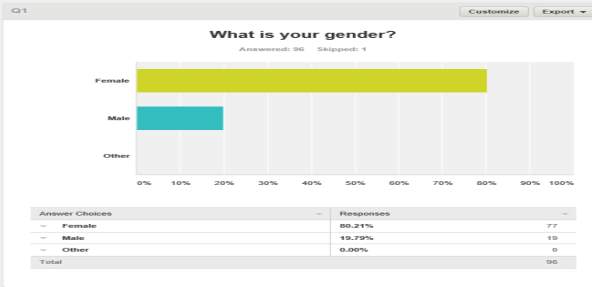
Fig 2.
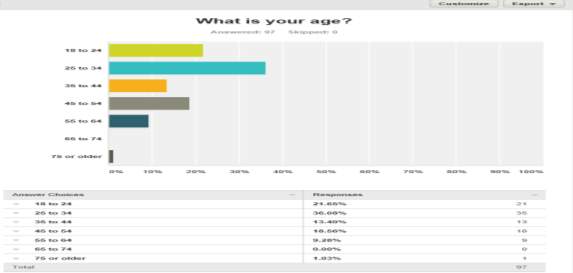
Figure 2 displays the age range of the individuals 50% of these individuals ranged in the 18-34 years old-35% in the 24-34 age category. The remainder of respondents fall into 35 and over. It may be worth giving participants the opportunity to be more specific when stating their age in future research. However, the fact that 50% of participants were under the age of 34 supports the above Generation Y study and the reliance and confidence with using social media.
Fig.3
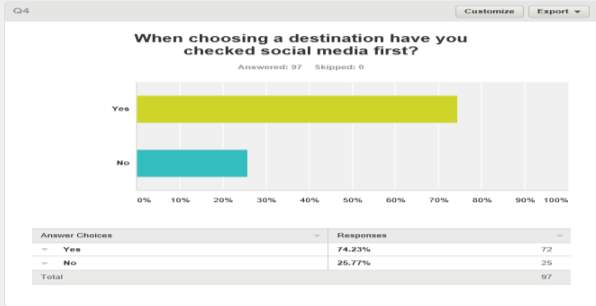
Figure 3 displays the figures for people that used social media to research a destination before selecting it. This demonstrates that a dependency for information on a specific is in 74% of respondents and 26% chose to go without the need for outside confirmation. Although the ultimate outcome is that the majority of participants rely mainly on word of mouth, there is still a clear link and reliance on social media when choosing destination.
Fig 4.
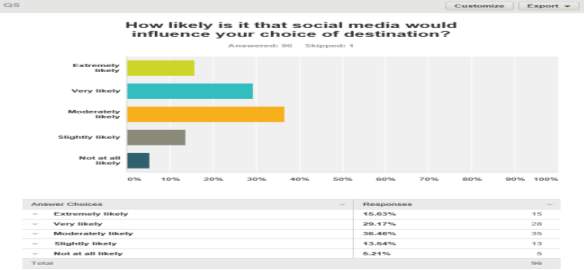
With figure 4, this shows what people believe the influence of social media has on their choice of destination. The largest number of people believe that social media plays a moderate likely hood that it would influence their decision making. Only 26% of participants are very likely to let social media influence their choice of destination.
Fig 5.
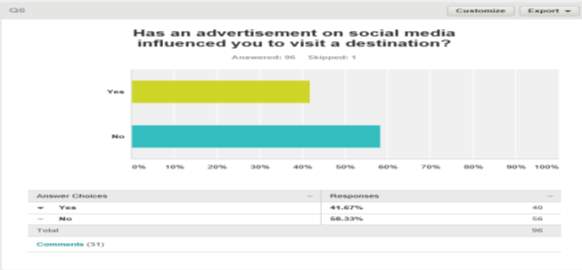
The response to this question, in some manner supports the previous question. It demonstrates that although many the participants have said that an advertisement on social media has influenced, the majority said that it did not have an influence on their decision.
Fig.6.
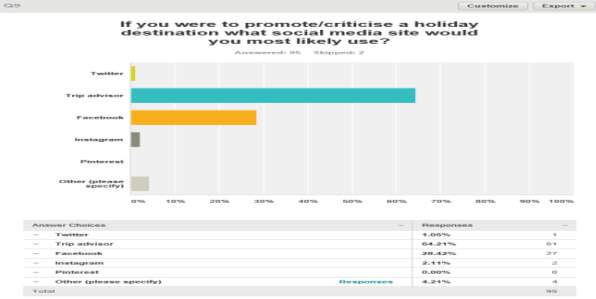
Fig.7
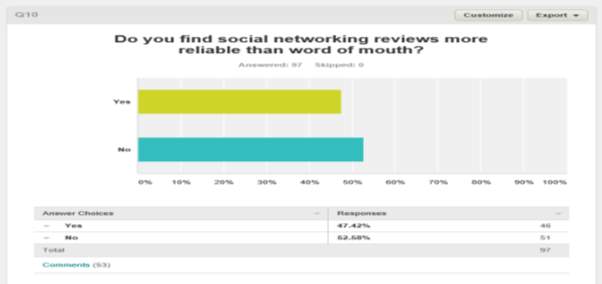
While many respondents expressed that if they were to make a complaint or promote a specific holiday destination, they would use TripAdvisor, the majority of participants still believe that the traditional word of mouth is more reliable than social networking reviews. According to Bolton et al, (2013), the social media platform had actually existed since 1981, but it wasn’t until 2003 that it was actually widely adopted. With this in mind, it may be this inexperience or lack of knowledge that prevents the 51% of participants in the study from trusting social media outlets for information on tourist destinations.
5.0 Limitations and Future Developments
This study could have shown a lot more information and has left gaps and motivations for further research. The study helps to fill a gap in knowledge that will continue to exist in the literature. The questionnaire developed could have been a lot longer to included more details of which webpage was the most effective in its destination promotion. The questionnaire also needed a larger number of respondents to correctly represent the public’s views. In further research, I would recommend increasing the numbers to over one thousand respondents as I believe this could help to gain more data to analysis. The main age range was also a poor reflection of the study with mainly the younger respondents answering the questionnaire so targeting a larger audience like with the Generation Y study and putting requirements on how many from each age group could filter the results to bring more validity to the study. However, this could also highlight the lack of confidence older members of society have in accessing the internet and using it for a reliable source of information for their holiday destination.
The next recommendation would be to hold a focus groups over a long period to gain the views of people within a group setting. This would give the researcher the opportunity to gain more information to compare and support with the results of data collected from questionnaires. A mixed method approach would open the answers received in the questionnaires, as many of the results were short and to a point. (Creswell, 2014)
Through focusing the research on more specific tourism destinations would be more suitable as it would focus the study into how the destination marketing organisations compare to others rather than having it as an open section to any destination. For example, I would focus on destinations that are becoming increasingly popular and over a period of time and explore how and why this population rises. Would this be a result of social media? It could also help in understanding in where success is with one destination and why another is failing. This would be beneficial for both tourism destinations to know where they need to focus their marketing to increase the consumer numbers.
In addition to this, it would be extremely beneficial to hold interviews with Tour Agents and explore how they use social media for their method of promotion and destination marketing. One participant used Loka Travel to plan their East Coast adventure and this was as a result of their pro-active use of Instagram. On further investigation of this, Loka’s Instagram is packed with images of another backpackers’ experience on their trip. Through this, consumers can observe real life experiences of those who actually experienced the company. This further supports in my questionnaire how one participant mentioned how the use of pictures for advertisement-this was the main deal breaker for their choice of destination. This could highlight the power of using pictures for advertisements.
6.0 Conclusion
The aim of this dissertation was research how social media affects consumers opinions on tourism destinations. With the use of linked studies, I was able to explore strands to base my own research upon. From this, I could understand the first links made between Social Media and Tourism with the advancements that tour agents and destination marketers have made to keep up with the internet trends. It was easy to pinpoint that the establishment of Web 2.0 gave Travel 2.0 the opportunity to followed suit and gave the consumer more power and control over destination marketing and tourism content. Linking to this, I wanted to understand social media’s role in tourism and how developing a solid basis for social media and destination marketing a large section of all tourist destinations was imperative for the tourism consumer. The information found that domestic marketing organisations such as the Visitbritian.org helped to understand that an accessible online presence offering all platforms such as Facebook, Instagram and many of the other social media networks should play an integral role in each destination plans.
The data collection illustrated that there is a lot more data collection need in both methods and it has been recommended that a mixed method research should be employed for future studies. It has also been expressed the need to control the time scale that you set for the data collection and analysis as this will bring about more respondents and open the value of data collected.
It is felt that many times social media is a constant in people’s lives but it does not control every decision that people makes as demonstrated in my study and data collection. A consumers’ choice of destination has many other factors involved. Social media marketing is important for some people so it is effective and the work that tourism bodies do in social media will continue to follow the times.
7.0 References
Baggio, R and Klobas, J (2011). Quantative Methods: The Handbook. Bristol: Channel View. 6-12.
Bergman, M. (2009). Advances in mixed methods research. 1st ed. Los Angeles: Sage.
Coffey, H. (2017). This video of a passenger being dragged off a flight is making people angry. [online] The Independent. Available at: http://www.independent.co.uk/travel/news-and-advice/united-airlines-man-video-dragged-off-plane-overbooked-flight-3411-twitter-viral-a7676846.html [Accessed 2 May 2017
Creswell, J. (2014). Research design. 1st ed. Los Angeles: SAGE Publications.
Di Pietro, L., Di Virgilio, F. and Pantano, E. (2012). Social network for the choice of tourist destination: attitude and behavioural intention. Journal of Hospitality and Tourism Technology, 3(1), pp.60-76.
Faculty of Tourism & Hospitality Management in Opatija. Biennial International Congress. Tourism & Hospitality Industry. (2010). 1st ed. Tourism & Hospitality Management, pp.890-901.
Ghandour, R and Bakalova, R. (2014). Social Media influence on the holiday decision making process. Journal of organisational studies and innovation. 1 (2), p41-52.
Hannam, K. (2004). Tourism and development II: marketing destinations, experiences and crises. Progress in Development Studies, 4(3), pp.256-263.
Kaplan, A. and Haenlein, M. (2010). Users of the world, unite! The challenges and opportunities of Social Media. Business Horizons, 53(1), p.61.
Keynote.co.uk. (2017). Internet Advertising | Key Note. [online] Available at: https://www.keynote.co.uk/market-report/media-marketing/internet-advertising?full_report=true [Accessed 2 May 2017].
Knoblich, S., Martin, A., Nash, R. and Stansbie, P. (2016). Keys to success in Social Media Marketing (SMM) – Prospects for the German airline industry. Tourism and Hospitality Research, 17(2), pp.147-164.
Lefever,S, Dal, M and Matthíasdóttir, A . (2007). Online data collection in academic research: advantages and limitations. British Journal of Educational Technology. 38 (4), p574-582.
McIntosh, A. J., & Thyne, M. A. (2005). Understanding tourist behavior using the means-end chain theory. Annals of Tourism Research, 32(1), 259–262.
Mertler, C. (2002). Demonstrating the potential for web-based survey methodology with a case study. American Secondary Education, 30 (2), 49–62.
Munar, A. and Jacobsen, J. (2014). Motivations for sharing tourism experiences through social media. Tourism Management, 43, pp.46-54.
Muñoz‐Leiva, F., Hernández‐Méndez, J. and Sánchez‐Fernández, J. (2012). Generalising user behaviour in online travel sites through the Travel 2.0 website acceptance model. Online Information Review, 36(6), pp.879-883.
Papasolomou, I and Melanthiou, Y. (2012). Social Media: Marketing Public Relations’ New Best Friend. Journal of Promotion Managment . 18 (3), 319-328
Qualman, E. (2012). Socialnomics. 2nd ed. John Wiley & Sons Inc., p.ix.
Smith, T. (2017). Qualitative & Quantitative Research. Research Starters Education, 1, p.1.
Sparks, B. A., and Browning, V. (2011). The impact of online reviews on hotel booking intentions and perception of trust. Tourism Management, 32, 1310–1323
VisitBritain. (2017). Digital & online marketing. [online] Available at: https://www.visitbritain.org/digital-online-marketing [Accessed 4 May 2017].
Visitliverpool.com. (2017). Hello and welcome to Liverpool – a city of culture, heritage & people… – Visit Liverpool. [online] Available at: http://www.visitliverpool.com/ [Accessed 4 May 2017].
Weber, L. (2013). Marketing to the social web. 1st ed. Hoboken, N.J.: Wiley, pp.37-39.
Yoon, Y. and Uysal, M. (2005). An examination of the effects of motivation and satisfaction on destination loyalty: a structural model. Tourism Management, 26(1), pp.45-56.
Zivkovic, R., Gajic, J. and Brdar, I. (2014). The Impact Of Social Media on Tourism. Impact of Internet on Business Activities in Serbia and Worldwide, p.758.
8.0 Appendices
Fig.1
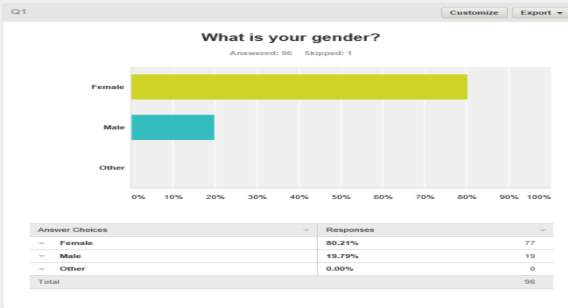
Fig.2
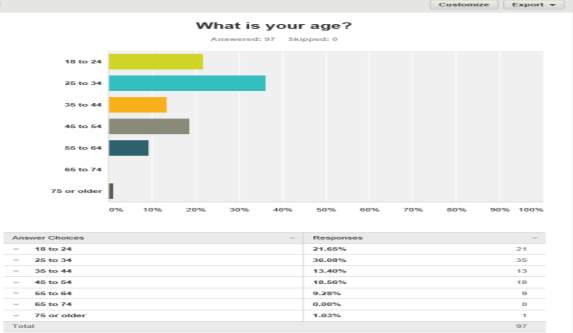
Fig.3
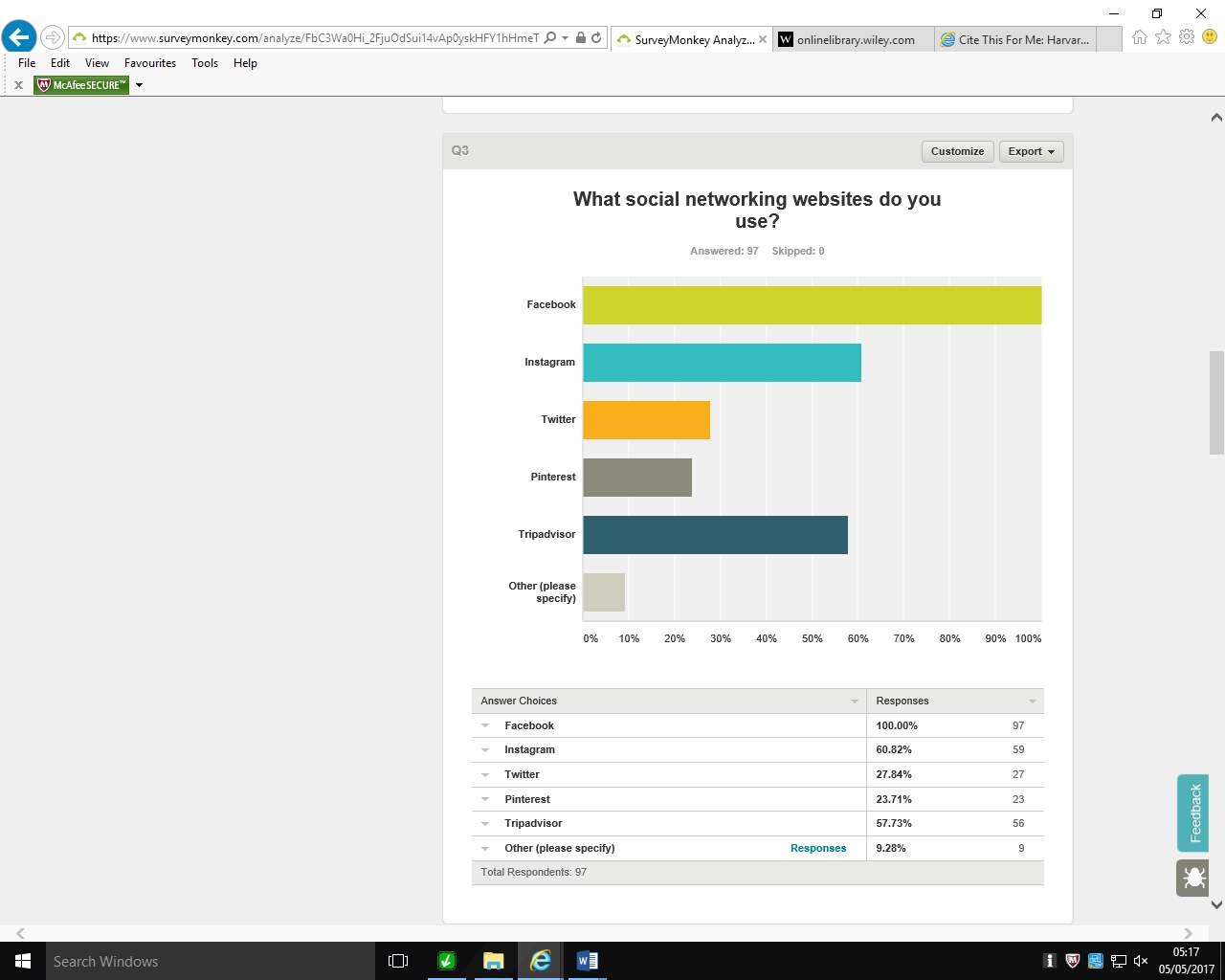
Fig.4
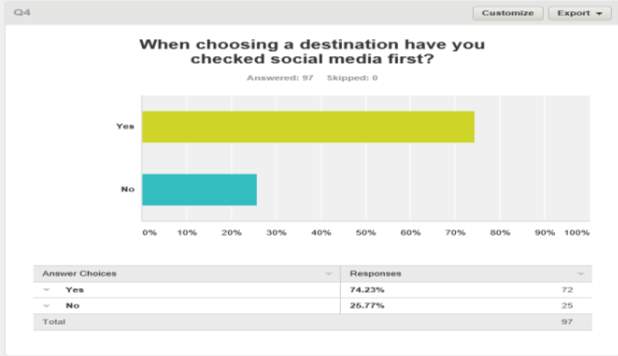
Fig.5
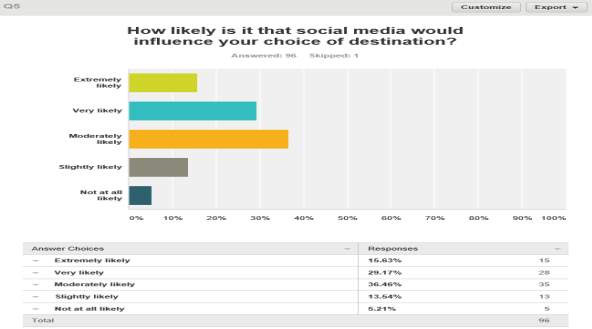
Fig.6
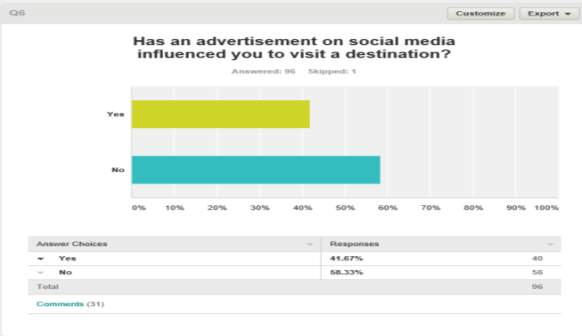
Fig.7

Fig.8
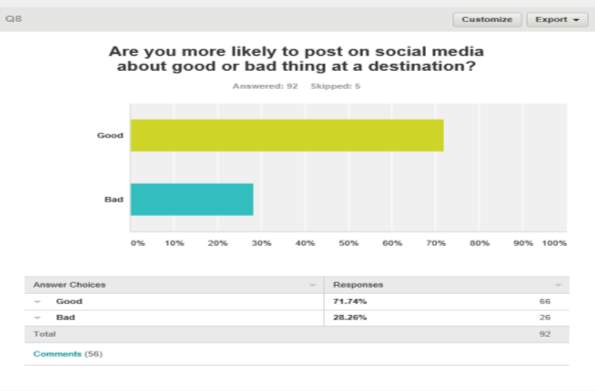
Fig.9
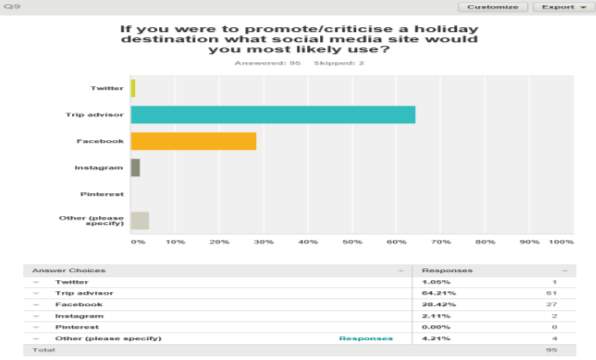
Fig.10
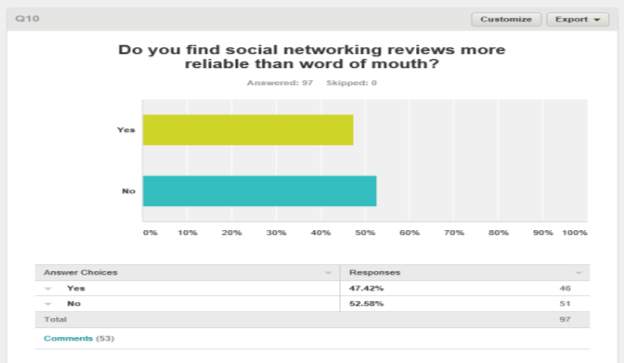
Cite This Work
To export a reference to this article please select a referencing stye below:
Related Services
View allRelated Content
All TagsContent relating to: "Travel and Tourism"
Travel and Tourism refers to travelling to places of interest, whether for pleasure or business. Tourist destinations will often have a multitude of attractions, food and drink venues, and other forms of entertainment for tourists to enjoy.
Related Articles
DMCA / Removal Request
If you are the original writer of this dissertation and no longer wish to have your work published on the UKDiss.com website then please:




